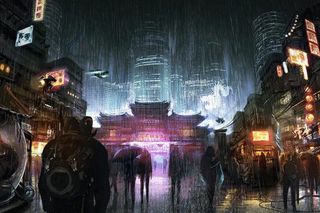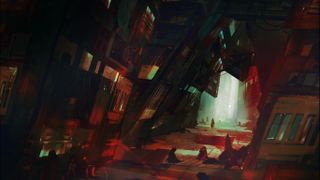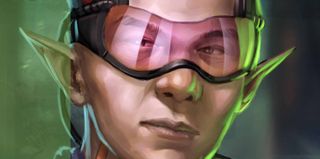Shadowrun: Hong Kong is a perfect portrait of a cyberpunk city fighting for revolution
If cyberpunk lives on, Shadowrun: Hong Kong should be its guiding light.

On May 21, 2022, construction broke ground on an ambitious project in Hong Kong’s Kowloon Walled City, turning the infamous slum into an enormous low-income housing development with the goal of helping poor people to help themselves. Naturally this wasn’t a benevolent charity endeavour, but a strategic master plan by an all-powerful megacorp whose CEO sat on the Hong Kong’s ruling Executive Council. While there would be walkable shops and amenities to support its residents, it was essentially designed to keep the city’s poorest out of sight, out of mind. It was called the Prosperity Project, and its slogan was "a place of dignity, where prosperity begins."
My return hit me like an armored truck full of orks
It never happened. The Prosperity Project was corrupt, and quickly devolved into squalor and violence. The people it was meant to serve were dehumanized as indigent lowlifes who couldn’t change their nature. It’s a universal truth that things can always get worse, but for those in the Walled City, life became a neverending series of unsettling new miseries.
This sounds par for the course under real-world hypercapitalism, but it’s a chapter of in-game history from Shadowrun: Hong Kong, one of the finest cyberpunk games ever made (the real Kowloon Walled City was demolished in 1993). Harebrained Schemes’ turn-based RPG Shadowrun Trilogy came out on consoles on June 21, so I reinstalled my favorite of the three, eager to get back into the series’ hybrid cyberpunk/fantasy Sixth World where shamanic spells and drone warfare go hand in hand. My return hit me like an armored truck full of orks.
Playing the game today is a strikingly different psychological and emotional experience, particularly in light of what Hong Kong has endured in the last few years. It was first released in 2015, a year after the student-led Hong Kong Umbrella Movement protested China’s attempts to influence election processes for the top political office of Chief Executive of Hong Kong. In 2019, a proposed Chinese extradition law reignited the pro-democracy movement, and led to a world-changing wave of protests that were ultimately brutally crushed by authorities.
As of 2020, Hong Kong lives under a draconian national security law that flies in the face of the "one country, two systems" approach that doesn't formally expire until 2047.
Walking through the game’s vividly realized depiction of the city (it’s 2056 in the free enterprise zone), Hong Kong’s existing corpocratic tendencies have been dialed up to 11 on the dystopia meter. The ruling Executive Council is a cabal of corporate billionaires who run the city, own the police, and control the news, which isn’t terribly far off from its current incarnation. When my freshly-rolled dwarf decker arrives at Victoria Harbour, I meet my estranged foster brother, Duncan, who hasn’t forgiven me for leaving home years ago. We’re a couple of dysfunctional Seattle orphans here to find our adoptive father—a born-and-bred Hongkonger—after receiving a cryptic message for help.

Our search leads us into the Walled City, often immortalized in western cyberpunk for its immense dystopian vibes. Tens of thousands of people are packed together in impossible, squalid conditions, making do as best as they could.
The biggest gaming news, reviews and hardware deals
Keep up to date with the most important stories and the best deals, as picked by the PC Gamer team.
A winning part of this particular Shadowrun game is the powerful synergy between its legendary setting and the irascible Hongkongness of its ensemble characters. Hong Kong has always belonged to its people, and Shadowrun knows this. All over the city, revisiting these slice-of-life stories is often frustrating, bittersweet, and deeply moving—painful memories, awkward conversations, reminders that my character’s Cantonese is shamefully rusty.

There’s a simple exchange at the beginning of the game where Duncan reminds my character to speak Cantonese—always Cantonese—and as a Southeast Asian who had an archteypically cantankerous Hongkonger grandmother, this familiar refrain hits hard in all the right places.
The simple linguistic reminder drives home the fact that despite my heritage, I’m in a strange land. And while neon lights and nighttime rain have become tedious visual shorthands in the cyberpunk genre, Hong Kong is one of the cities that built that myth. Moving away from the docks and into the shadowrunner haven of Heoi, it’s hard not to feel like the genre is truly home.
Cyberpunk is usually about current realities rather than distant futures, but reentering the Shadowrun world prompts a bitter swell of nostalgia. It’s been over a year since the world watched ordinary Hongkongers resist the growing yoke of mainland authoritarianism (followed by the ongoing pandemic), and it’s still painful and even a little dreamlike. My brain is actively fusing my sentimental memories of the game with the painful reality of Hong Kong’s present, and the flesh-and-blood Hongkongers I know who believed they could prevail.
Shadowrun: Hong Kong is so absorbing because it reflects the reality of the city’s demographics: there are obvious western expats (a euphemism for white immigrants), but the game is acutely conscious of the intersection between Hong Kong’s multicultural identity and its working class. I talk to Rosario "Cherry Pink" Ignacio, a Filipina ex-nanny who fled her dangerous employer, who reminisces about her days off with the other domestic workers sitting on bits of cardboard in parks and under bridges, gossiping and eating lumpia. The fact that the developers did the bare minimum to include these important pieces of cultural worldbuilding tells me two things:
- Real Hongkongers had input on the story—both Hong Kong and Singapore have a substantial domestic worker population that includes live-in maids (a societal standard that is often exploitative and abusive).
- That it is absolutely possible for white American developers to work with cultural experts to get to this level, something too many other cyberpunk games have failed to do.
There are few other cyberpunk games of Shadowrun: Hong Kong's caliber that wholeheartedly engage with the inherent orientalism and intra-Asian cultures and communities that make up Hong Kong’s rich cultural identity. It’s because of this narrative commitment to getting Hong Kong right that Shadowrun still hits hard today, and proof that western developers—Harebrained is a Seattle studio run by white men—are capable of producing culturally diverse games without defaulting to racism and appropriation.
The depth and care put into the writing means that the team actually valued and acted on the input from their consultants: a team of seven including game designer Norma Tu, who helped to identify language and cultural inaccuracies. (A story did emerge in 2018, however, that Harebrained designer Tyler Carpenter was guilty of persistent sexual misconduct and harassment, which affected fellow S:HK writer Elan Stimmel.)
The idea of shadowrunners coolly defying Hong Kong’s cops and elite politicians isn’t the same escapist fantasy anymore
Cherry Pink is part of the city’s robust Pinoy community that bonds over food online, with users posturing over pancit (noodle) and dinuguan (pork and pig blood stew). In different neighborhoods, I meet more immigrants—an Irish monster hunter who hangs out in a Whampoan arcade, a Japanese dango seller obsessed with soap operas, an ex-anarchist Berliner who can compartmentalize memories. I bump into a Chinese-Irish hacker at a decker convention who witheringly informs me that there are, in fact, Asian people in Ireland.
Eccentric American expats keep a low profile in the shadows. I learn about the pan-African enclave in Chungking Mansions and how my fellow decker, is0bel, lived in a poor man’s version of the Mansions in the Walled City. Nearly every NPC is a fully-fledged person—a tiny part of a city brimming with personality. Reliable Matthew, a used drone salesman, is so evocatively pathetic that I almost want to hand the guy a few bucks through the screen.
At one point in the Walled City I come across an injured student from Hong Kong University, desperately trying to finish her research on feng shui in the slums. Feng shui isn’t just about organizing furniture to attract good qi (气 - in simple terms, dynamic life force/energy). The study of manipulating harmony and auspiciousness in human environments has been part of history for centuries across the world's cultures. Even the tiniest changes can make a difference between everyday bad luck and catastrophe. And in the game, feng shui isn’t just a philosophical system—it’s real magic.



I never learn the student’s name. Her work seems small, but it is important. She needs my help to make adjustments to the qi flow in the slums. It's a metaphysical band-aid in the face of the growing rot at the city’s core, but enough to help its people survive a little longer.
Meeting this determined young woman amid the fictional chaos and suffering now has a miserable new layer of meaning. Over the past few years, Hong Kong’s youth bore the brunt of the authorities’ crackdown on pro-democracy protests. HKU was famously home to the Pillar of Shame, a monument to the victims of the Tiananmen massacre in 1989, as well as the Democracy Wall, a place for protest posters and messages. Both were removed after last year’s protests, as if nothing had ever been there.
The idea of shadowrunners—hackers, fixers, and jack-of-all-trades mercenaries—coolly defying Hong Kong’s cops and elite politicians isn’t the same escapist fantasy anymore. It’s hard to forget the raw, very real images of the Hong Kong Police Force beating the shit out of kids and old people, claims of torture, and protester suicides that many suspect were murders. Cyberpunk escapism as pure indulgence doesn’t have quite the same potency.

For more on cyberpunk, check out:
- It's time for cyberpunk to remember how to be punk
- Cyberpunk games on PC better than Cyberpunk 2077
- How to have the best Deus Ex-perience in 2022
- Citizen Sleeper review
Instead, let Shadowrun: Hong Kong stand as an example of thoughtful engagement with the momentous influence of East Asian culture and psychology on what we call cyberpunk today. Even besides all the fantastic cultural details and efforts to demonstrate the breadth of Hong Kong’s multiculturalism, the writers also had a fan-fucking-tastic grasp of internet communities that reflected the city’s subcultures. My favorite forum drama in the game is the emergence of a rogue poetry bot that drives the bulletin board admin up the wall.
In many ways Shadowrun: Hong Kong is a precursor to the fresh, imaginative strains of hyperlocal cyberpunk in the form of Norco and Citizen Sleeper and Umurangi Generation. All are wonderful explorations of contained communities and their unique material realities. If cyberpunk must endure, it needs to move away from the nameless megacity dystopias where everything blends into an indistinguishable, generic grey fog. A genre that once cautioned against technocorporacy and the most venal effects of hypercapitalism has long lost its bite in a world that runs on dystopian messaging.
If cyberpunk must live on, Shadowrun: Hong Kong is a reminder of how to dig deep into the heart and specificity of place, so that the genre and its neverending technology-driven miseries becomes a righteous engine for powerful, culturally important stories.

Alexis Ong is a freelance culture journalist based in Singapore, mostly focused on games, science fiction, weird tech, and internet culture. For PC Gamer Alexis has flexed her skills in internet archeology by profiling the original streamer and taking us back to 1997's groundbreaking all-women Quake tournament. When she can get away with it she spends her days writing about FMV games and point-and-click adventures, somehow ranking every single Sierra adventure and living to tell the tale.
In past lives Alexis has been a music journalist, a West Hollywood gym owner, and a professional TV watcher. You can find her work on other sites including The Verge, The Washington Post, Eurogamer and Tor.
Most Popular


